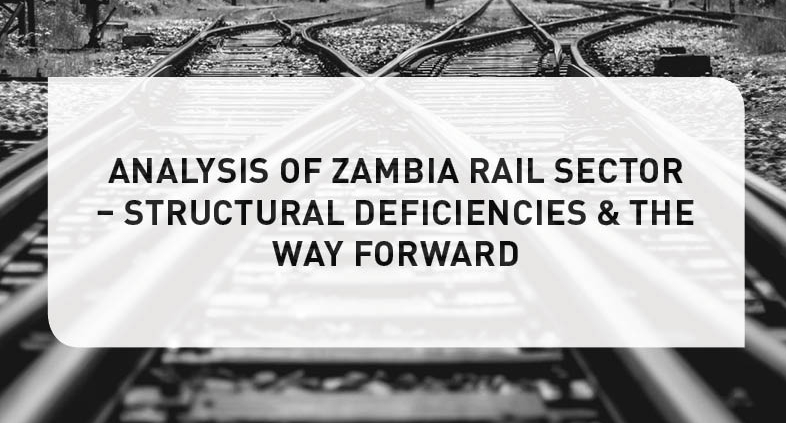The railway system in Zambia is comprised of an extensive network of surface transport with the potential to offer safe, efficient, and environmentally friendly transport across the country and the region, connecting all major centres of economic activity and facilitating growth.
There are two main players in the Zambian Rail Sector, namely, Zambian Railways Limited (ZRL) and Tanzania-Zambia Railway Authority Railway Authority (TAZARA). ZRL is wholly owned by the Zambian Government and manages a rail track covering almost 1,000 km. Since the time of concession from 2003 to 2012, the tonnage moved on rail had declined drastically from 1,323,191mt in 2004 to 690,793mt in 2009. This was due to a lack of investment in track rehabilitation and infrastructure upgrades by the concessionaire. After the cancellation of the concession on 10th September 2012, tonnage moved improved marginally to 702,603mt in 2017.
TAZARA on the other hand is co-owned by the Governments of Zambia and Tanzania. It is a key railway that covers approximately 1,900 km from Kapiri-Mposhi in Zambia to Dar-es-Salaam in Tanzania. Amidst daunting operational challenges, TAZARA’s annual freight traffic volumes hit a low of 122,473mt in 2015 compared for instance to figures of over 530,000mt in 2010.
Challenges in the sector
The railway traffic dwindled to current levels following the deregulation of road transport in the region, due to high fixed costs, low investments in rail track infrastructure, working capital and rolling stock. There is also a lack of integration among railway companies within the region who have opted to operate as autonomous entities. The average speed of locomotives has also averaged 40km per hour, which is too slow for modern business.
Another challenge relates to the fact that TAZARA and ZRL have insufficient locomotives and wagons. For instance, in 2014, ZRL had a total locomotive fleet holding of 37, out of which 24 were operational while 13 were defective and extensively cannibalized.
Government interventions to increase rail freight
The Seventh National Development Plan (7NDP) prioritizes the construction of new rail spurs and the rehabilitation of existing lines to increase operational efficiency, reduce the cost of freight, and increase the tonnage being carried. Furthermore, the Government has pledged to encourage private investment in the construction of other rail spurs, including intra-city transit systems. Plans are also in place to migrate the rail gauge from the existing Cape gauge to Standard gauge to enable higher speeds and higher tonnage of freight. In 2012, Government nullified its concession with the Railway System of Zambia (RSZ) in 2012, leading to an 18% growth in the traffic of ZRL between 2012 and 2017. In October 2018, The Industrial Development Corporation (IDC) Board approved an investment of $850 million into rail infrastructure and rolling stock for ZRL. This investment is important because it is a wholesome package intended to alleviate capacity constraints of ZRL.
In January 2012, Government brought into effect a Statutory Instrument (SI) to compel transporters of heavy cargo to move 30% of bulk cargo from road to railway in order to optimize the transport sector and promote the sustainability of the rail subsector. The implementation of the 30% quota system is aimed at preserving road infrastructure as well as increasing revenue and efficiency in the railway operations.
Recommendations and way forward
- There is need to unbundle the rail line operations through the creation of the Railway Development Agency, so that rail infrastructure development and management are separated from operations. ZRL will focus on running its business operations competitively and in a sustainable manner without focusing on maintenance and investment in rail track infrastructure.
- Government is urged to continue with maintenance and upgrading of rail infrastructure to reach the desired speed of 80km per hour for freight trains and 120km per hour for passenger trains.
- Zambia should engage in bilateral/multilateral railway route management groups with other countries to collaborate on rail use and infrastructure development to increase volumes and ensure the sustainability of the rail sector.
- Government is urged to change the policy environment and encourage private train operators to join the Rail Sector industry. These operators can then be charged for use of rail track infrastructure, thereby boosting Government revenues.
- After liberalization of the rail sector, Government would then need to institute a regulatory body to monitor market performance, competition and safety issues to complement the work of the General Inspector of Railways at the Ministry of Transport and communications.
This article is an extract from a PMRC Analysis of Zambia Rail Sector – Structural Deficiencies & the Way Forward. . To access the analysis visit www.pmrczambia.com




